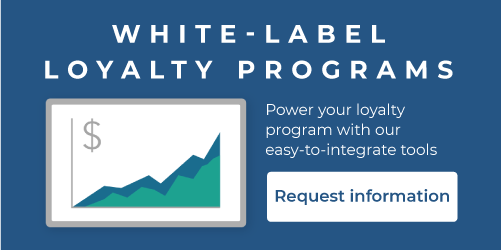Frequent flyer programs are the granddaddy of modern loyalty programs. In all the years they’ve been around, they continue to excite, engage, and reward participants. Members not only receive discounted airline tickets but can redeem their points for everything from overnight hotel stays to car rentals, magazines, and more.
Banks can follow the four core pillars behind airline loyalty programs and figure out how to incorporate these principles into their own programs for maximum customer adoption. As digital-first “challenger banks” multiply, taking market share from traditional financial institutions, customer loyalty in banking will become even more important.
Here are four critical aspects of airlines' success in their loyalty programs that financial institutions should consider as they look to build out their own.
The Four Pillars of a Successful Loyalty Program
Airlines have largely succeeded with their loyalty programs because they meet these four criteria: their programs are Relevant, are Effortless, they Meet the Customer Where They Are, and are Rewarding. Let's break down these four criteria:
1) Relevant
A customer rewards program must be relevant to not only the customer, but to the company itself. Airlines will often offer flight credits, in-flight perks, and other related bonuses as rewards in their programs. Obviously, additional travel-related services are extremely relevant to an airline customer.
Airlines frequently recommend other deals related to a customer's destination. They might offer a deal at a hotel or a special rate on a car rental from that airport. Airlines utilize their consumer data to personalize their shopping experience and provide relevant, thematic rewards to program participants.
Similarly, a bank’s loyalty/rewards program should be germane to the customer's financial life. After all, that’s why they work with a bank - to help them look after their money.
Banks can tap into this mission by offering rewards that are in line with the theme of contributing to customers’ overall financial health.
To that end, some digital-first banks, and some established financial institutions too, are introducing features like financial education and incentives for saving so customers can learn about, and be rewarded for, managing their money better. Others have loyalty program features that help customers contribute to retirement accounts by facilitating small deposits over time. Still others are introducing tools to help customers save money and find deals, and/or earn cashback rewards as they shop.
2) Effortless
The second pillar of a successful loyalty program is that it must be effortless. Airline loyalty programs are easy to join and participate in. Once a customer joins, they can automatically earn more credits (miles, points, etc.) in the program, simply by providing their member number or using the airline app when they make a reservation.
Banks can replicate this effortlessness in their own loyalty programs by making it as easy as possible for a customer to join and use it regularly. Excessive fine print, lengthy sign-up processes, complicated rules, and convoluted redemption steps will discourage users from participating at all.
From signup, to earning, to redeeming rewards, the most effective and well-utilized loyalty programs fit naturally into customers' everyday lives. The fewer hoops a loyalty program makes customers jump through, the higher the chance they will join and continue participating in the program.
Financial institutions should also make it easy for customers to understand what their loyalty points help them achieve. Points (or any other internal “currency”) need to have a clear value to customers, or customers won’t take the time to utilize them.
To this end, banks should consider extending the notion of effortlessness and simplicity to their program’s reward tender itself and making a reward such as simple cashback, or conversion of cash to statement credits or reduced fees, a loyalty program currency.
3) Meets the Customer Where They Are
Airline programs often allow customers to earn miles and rewards in ways besides just taking actual flights. This omnichannel approach to their loyalty programs helps the airline meet the customer where they are and continue participating in the program beyond simply flying.
For example, American Airlines offers users rewards for donating to specific causes, shopping with AA partners, or dining and paying with a linked credit or debit card. United Airlines lets customers earn miles when they use partner credit cards, shop or dine at partner stores and restaurants, or use one of their financial partners. These airlines use their partnerships to expand how customers can earn more.
Customers should be able to access several avenues to earn rewards. Especially in today’s digital-first world, a loyalty program must reward customers seamlessly, without making them jump through any hoops. It must also add value for all their interactions across multiple channels - such as interacting with customer support, signing up for email newsletter subscriptions, making charitable donations, or earning cashback when they spend money at e-commerce stores.
4) Rewarding
Above all, a loyalty program must be rewarding to be as valuable as possible to the end consumer. Otherwise, why would they participate?
Airline loyalty programs offer a great example of this fourth loyalty program pillar, in that airline loyalty program customers can redeem their miles for rewards far beyond just flights.
Airlines offer program rewards like lounge access, waived bag check fees, free concerts, gift cards, and more. The more customers participate, the more they can earn for a wide variety of rewards.
Banks, too, need to consider what they offer their customers as loyalty currency to ensure the rewards provide real value to loyalty program participants. Utilize data or ask customers what kind of rewards they find most beneficial. Or, tie a reward currency to the overall mission or branding of the company.
And ultimately, don’t forget that the loyalty program should be “rewarding” to the company itself, in the form of higher lifetime-value-customers, reduced churn, and more incremental revenue.
Optimizing Your Loyalty Program
Customer loyalty programs are critical for banks to both attract new customers and retain existing ones in the battle for market share with nimble digital-first banks. Using the four pillars above, financial institutions can take a page out of airlines’ books and model loyalty programs that offer more value, drive greater customer retention, and create a new income stream outside of “traditional” banking revenue models.


